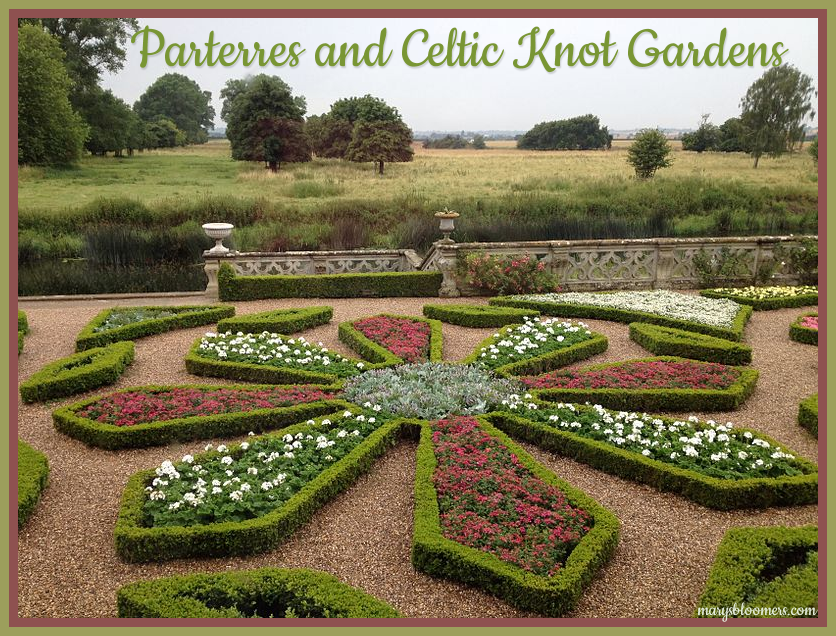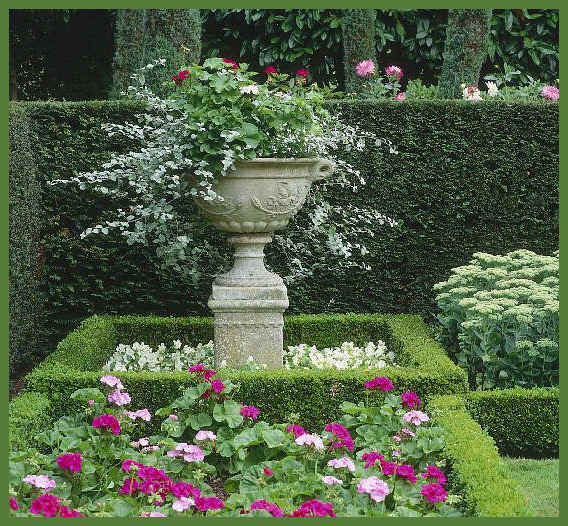|
|
|
Formal parterre recreated from original 1700 plans at
Charlecote Park, Warwickshire |
|
Parterre comes from 17th century French "par terre", which means ‘on the ground’. A parterre is a level space within a garden or landscape that is dedicated to a formal artistic arrangement of flower beds. Most parterres feature gravel walkways and tiny hedges. A parterre is a formal garden constructed on a level substrate, consisting of plant beds, typically in symmetrical patterns, which are separated and connected by paths. The borders of the plant beds may be formed with stone or tightly pruned hedging, and their interiors may be planted with flowers or other plants or filled with mulch or gravel. The paths are constituted with gravel or turf grass. Parterre gardens, with their decorative arrangement of beds and paths laid out according to centuries’ old geometric or embroidery-inspired patterns. An ornamental garden with paths between the beds. French parterres originated in the gardens of the French Renaissance of the 15th century and often had the form of knot gardens. Later, in the 17th century Baroque garden, they became more elaborate and stylized. The French parterre reached its greatest development at the Palace of Versailles, which inspired many similar parterres throughout Europe. In 1638, Jacques Boyceau described the range of designs in boxwood that a horticulturist should be able to cultivate:
By the 1630s, elaborate parterres de broderie appeared at Wilton House in Wilton, England that were so magnificent that they were engraved, and the engraving is the only remaining trace of them. "Parterres de pelouse" or "parterres de gazon" denominate cutwork parterres of low growing herbs, e. g. chamomile, as much as closely cut turf grass.
Knot gardens are a type of parterre, but bigger and more intricate. |
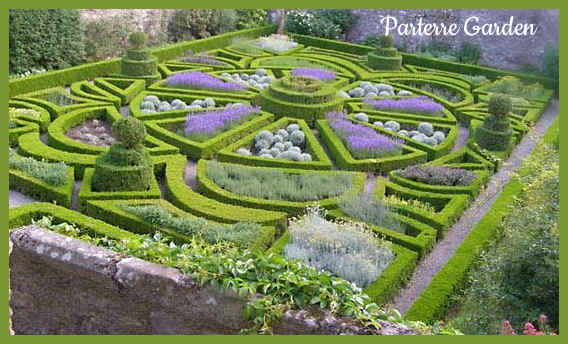 |
|
Parterre garden at Bodysgallen Hall, Wales. Photo: Michael Hogan |
|
One of the earliest and most famous examples is at the Palace of Versailles. Ideas for symmetrical bedsParterres can be part of gardens of all sizes, at home in tiny courtyards, as well as in large walled gardens of many beds filled with flowers and vegetables. Most are based on geometric shapes, arranged in a formal layout of triangles, squares, diamonds, wedges or rectangles, and separated by paths. The simplest shape for creating Parterre gardens is a cross, but you can get creative with triangles and other geometric shapes fit together. The most pleasing have fewer, larger beds, as opposed to lots of fussy, small ones, providing it is possible to reach the center of each bed comfortably without treading on, and compacting, the soil. Edges outline each bed, but in undemanding schemes, the hedges are replaced with raised edges of reclaimed terracotta roof tiles or bricks placed in the ground, either upright or at an angle. |
Parterres for a small space
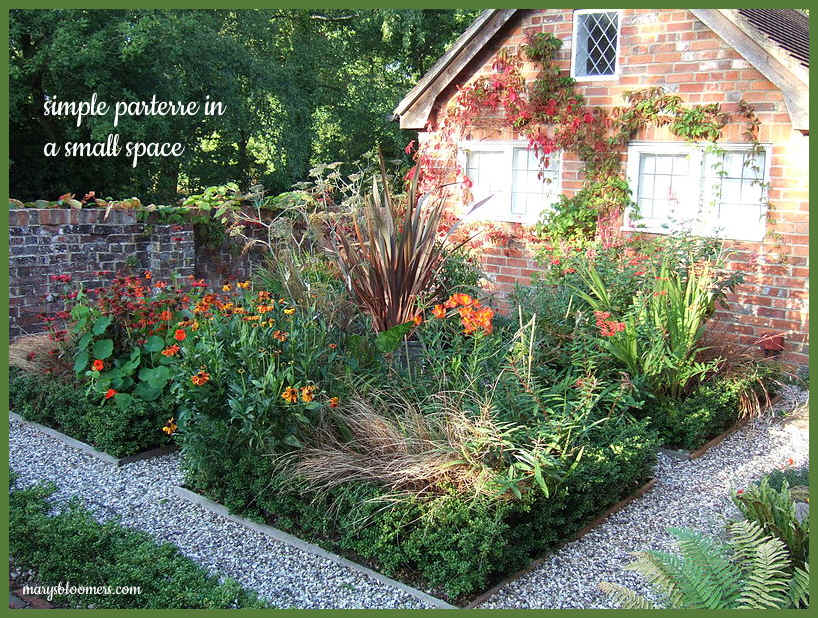 |
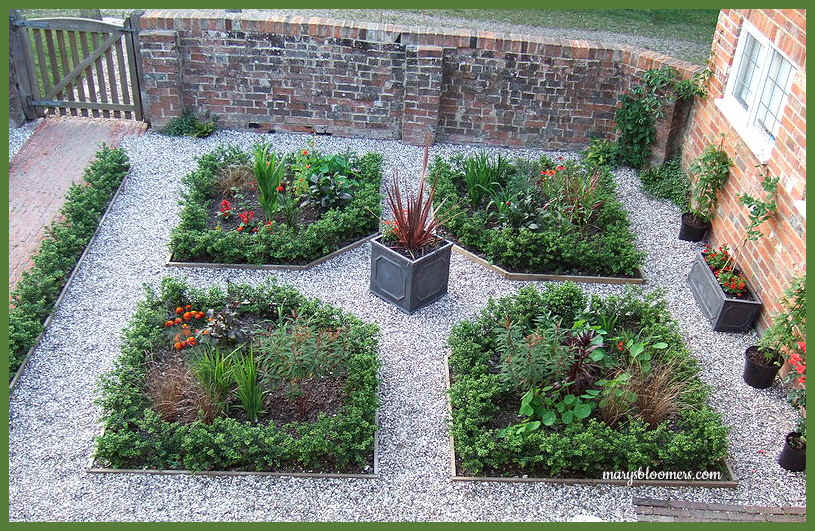 |
|
when the parterre was planted... |
|
A rectangular shape can fit nicely beside a patio, or across the length of an existing access path, or even where levels change, so it can be viewed from above. Generally, the simplest designs work best in a small space, and if a single bed is narrow enough, plants can be tended from the sides without the need for hard landscaping in between. Curves or circular box-edged beds are a good basis for designs in front gardens where the shape is often more fragmented. A central geometric parterre helps counteract a wide shallow plot by adjusting the perspective. In this situation, you can emphasize a shallow garden by adding a straight path through the center, with perhaps an urn in the center that you can walk around. By positioning potted trees in a pattern within the beds and adding a twisted topiary or dwarf fruit tree at each corner, the boundaries are hidden from view increasing the feeling of space. Paths and archesPaths form a vital part of the overall pattern, not only serving to frame each section, but also providing essential access for weeding, watering and planting. While grass paths look nice if kept well, there are also low-maintenance options such brick, paving, gravel or bark nuggets. I am anti-grass, so mine would be hard-scaped. Arches add a vertical dimension to a parterre, straddling paths and supporting climbing plants. An effective and simple parterre consists of four square beds, grouped a round a central focal point, while an arch over each path frames the view within. |
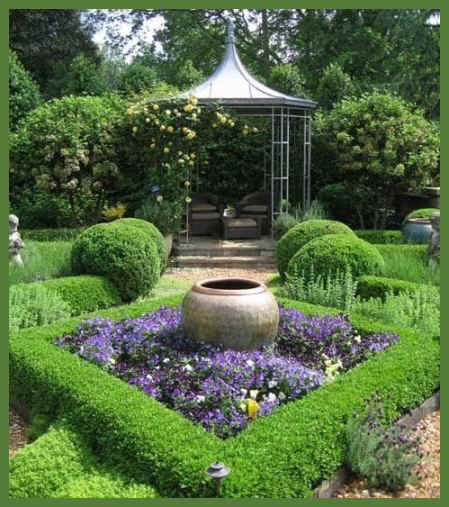 |
|
Focal pointsIt could be as simple as an urn filled with an evergreen, and draping flower plants, or as dramatic as an arbor over which fruit trees are trained. Ornaments such as statues, sundials, armillary spheres or birdbaths also create eye-catching focal points, provided they are raised high enough on a base of some sort, and encircled by plants – a carpet of thyme, lavender or a winding clematis, dwarf topiaries, or obelisks. Proportion is key, and while a feature should be large and elaborate enough to attract attention, it should not be so imposing as to overshadow everything else. As a general rule of thumb, for every 9 1/2 feet of a parterre’s diameter, the central feature should be around 3ft. tall. If space is so tight that a parterre consists only of a couple of beds, then consider adding a central focal point to each, like a dwarf fruit tree. Whatever the hedging, there is the question of filling each bed. It can be as simple as gravel or pebbles, or as complex as a tiered planting. In the same bed, taller plants can be underplanted with a succession of bulbs – snowdrops, narcissus and hyacinths. Then, as the first round of bulbs dies back, alliums and tulips take over, while alchemilla, aquilegias, heucheras, euphorbias and hardy geraniums carpet the ground, concealing the bulbs’ dying foliage. Filling it in for the SummerBy summer, taller perennials such as Verbena, campanulas, foxgloves and poppies bring plenty of color. Or there are annuals like snapdragons, French marigolds, cosmos, tobacco plants or nemesias. Herbs also look good – oregano, marjoram, fennel, bergamot, yarrow and
feverfew have a free and disheveled habit that contrasts well against the
clean-cut box hedges. Whatever your color blends and texture combinations, the highest consideration when planning a parterre is proportion. This means arranging the plants so that the eventual height and spread of each is neither overpowering, nor lost within the overall scheme. This is especially important in a small parterre where it is best to avoid invasive aggressive plants like yellow loosestrife, Japanese anemone or golden rod, all of which will eventually crowd out the others. |
